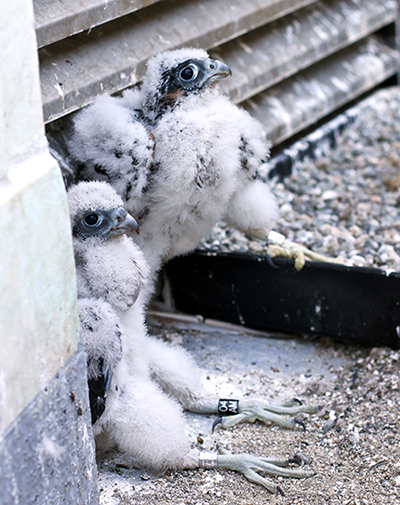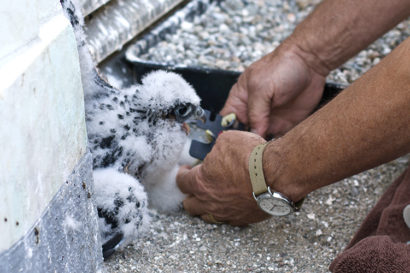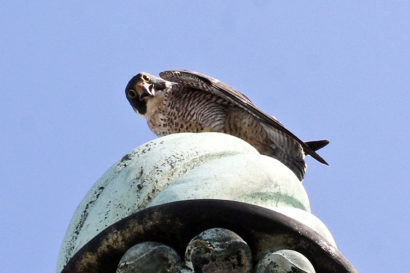Peregrine falcon chicks on Campanile now banded, getting ready to fly
Experts made their way to the second balcony of the Campanile Monday to put identifying bands on two peregrine falcon chicks, whose family made a home on the 307-foot bell tower last month
June 19, 2017
Experts made their way to the second balcony of the Campanile today to band two peregrine falcon chicks, whose family made a home on the 307-foot bell tower last month. The chicks are believed to have hatched on May 22.

Peregrine falcon chick on the Campanile (Photo by Mary Malec)
Glenn Stewart, of the Santa Cruz Predatory Bird Research Group, and Doug Bell, of the East Bay Regional Park District, worked together to ensure the safety of the chicks while they put bands on two female chicks. Mary Malec, a volunteer raptor nest monitor for East Bay Regional Park District, accompanied the team. She took photos and provided the following description:
While we were gathering, we saw the adult female take food into the nest area. About 10 minutes later we went up the tower. We got up to the nest level at about 10:10 a.m. From inside the cupola, we could see one juvenile near the nest and could hear an adult nearby. We knew the approximate age of the chicks and wanted to gather them together close to the nest area so one person went around the tower in one direction and one person went from the other direction.
One chick was standing at the side of the nest box. The other was several feet away on the floor of the balcony level. The chick farthest from the nest was carefully secured and left to wait on the cool floor. Glenn Stewart, of the Santa Cruz Predatory Bird Research Group, started to band the chick as it stood in place near the nest. The adult female was circling the tower and cakking at us most of the time we were in the nest area. The adult male also circled at a farther distance. The adult female landed on top of the northwest spire several times, and several times landed on the west balcony and on the north balcony.

Both peregrine chicks are now banded. They are expected to fledge on about July 4. (Photo by Mary Malec)
Glenn finished with the first chick and picked up the second and banded it, assisted by Doug Bell of East Bay Regional Park District. One unhatched egg remained in the nest box. It is too late for that egg to hatch.
We finished and were headed down in the elevator by 10:28 a.m. The adults continued to circle the tower, but settled down a few minutes after we left the tower.
Based on their size, both chicks are females. We expect they will leave the nest and fly for the first time around July 4.
Banding is done for studying the movement, survival and behavior of birds nationally and internationally. The adult male is banded. By reading his band and reporting it to the Federal Bird Banding Laboratory, we know how old he is and where he was hatched (2013/Solano County). In future years, we will be able to confirm whether or not the same adult male is breeding at Cal. The female is not banded. We don’t know where she comes from or how old she is.
If these chicks are seen in the future, we will know where they have gone off to.
Banding is regulated and overseen by the Bird Banding Laboratory, associated with Patuxent Wildlife Research Center of the USGS.
Two types of bands were placed on the peregrine chicks: an aluminum band with a unique 9-digit number, and the phone number and email of the banding laboratory. Typically, this information is only reported when the bird is found dead or has been captured. The other band is a black-and-white visual identification band with an alphanumeric code, which allows the birds to be identified with a spotting scope. The two peregrine chicks on the Campanile have codes 03/AM and 04/AM.
Learn more about the Campanile’s first peregrine falcon family on Berkeley News.

